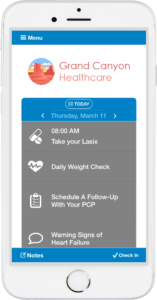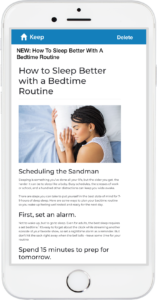Focus clinical team members on the right patients
TapCloud provides the information and tools to direct critical resources to where they are needed most. The patient app collects and combines detailed information on symptom progression, treatment adherence and side effects, well-being trends, vital signs and more into an AI-driven clinical rules engine that detects which patients are in need and why.
Clinical teams are automatically alerted to patients in need, providing deep insights into cause and effect for quick issue resolution and saved time on the phone and in patients’ homes trying to determine issue root cause.
Just as important, TapCloud promotes patient self-management through personalized, automated interactions. Care team members can easily see who is doing well and redirect critical resources based on need in real-time.

Focus clinical team members on the right patients
TapCloud provides the information and tools to direct critical resources to where they are needed most. The patient app collects and combines detailed information on symptom progression, treatment adherence and side effects, well-being trends, vital signs and more into an AI-driven clinical rules engine that detects which patients are in need and why.
Clinical teams are automatically alerted to patients in need, providing deep insights into cause and effect for quick issue resolution and saved time on the phone and in patients’ homes trying to determine issue root cause.
Just as important, TapCloud promotes patient self-management through personalized, automated interactions. Care team members can easily see who is doing well and redirect critical resources based on need in real-time.


Identify who needs help and act fast with deep insights
Receive proactive alerts for issues requiring intervention.
- Concerning symptoms, pain levels and vital signs
- Repeated medication adherence issues
- Repeated non-compliance with prescribed activities
- Supply or equipment requests
- Patient-reported SDOH and ADL issues
Reduce time spent questioning the patient to discover issues and root causes.
- Overall well-being trend and stress, anxiety and depression levels
- Pain trends and use of pain medication and alternate pain management techniques
- Timing of symptom onset and progression
- Treatment efficacy and side effects
- Medication and care plan adherence
- Mobility, sleep, nutrition and other ADL patterns
- Family caregiver input
Identify who needs help and act fast with deep insights
Receive alerts for issues requiring intervention.
- Concerning symptoms, pain levels and vital signs
- Repeated medication adherence issues
- Repeated non-compliance with prescribed activities
- Supply or equipment requests
- Patient-reported SDOH and ADL issue

Reduce time spent questioning the patient to discover issues and root causes.
- Overall well-being trend and stress, anxiety and depression levels
- Pain trends and use of pain medication and alternate pain management techniques
- Timing of symptom onset and progression
- Treatment efficacy and side effects
- Medication and care plan adherence
- Mobility, sleep, nutrition and other ADL patterns
- Family caregiver input
Secure, multi-channel patient communication
Identify opportunities for patient self-management of symptoms and care where appropriate, allowing the redirection of clinical resources to patients most in need.
- Deliver education and tools for management of symptoms such as nausea, headaches, trouble sleeping and stress
- Collect deeper information about reported symptoms to determine seriousness/urgency
- Request photos of issues requiring physical observation such as wound healing or foot swelling
- Proactively gather patient availability for a video call or home visit in the instance that manual intervention is needed
Promote self-management with personalized, automated interactions
Identify opportunities for patient self-management of symptoms and care where appropriate, allowing the redirection of clinical resources to patients most in need. Leverage automation to:
- Deliver education and tools for management of symptoms such as nausea, headaches, trouble sleeping and stress
- Collect deeper information about reported symptoms to determine seriousness/urgency
- Request photos of issues requiring physical observation such as wound healing or foot swelling
- Proactively gather patient availability for a video call or home visit in the instance that manual intervention is needed


Promote self-management with personalized, automated interactions
Identify opportunities for patient self-management of symptoms and care where appropriate, allowing the redirection of clinical resources to patients most in need. Leverage automation to:
- Deliver education and tools for management of symptoms such as nausea, headaches, trouble sleeping and stress
- Collect deeper information about reported symptoms to determine seriousness/urgency
- Request photos of issues requiring physical observation such as wound healing or foot swelling
- Proactively gather patient availability for a video call or home visit in the instance that manual intervention is needed



